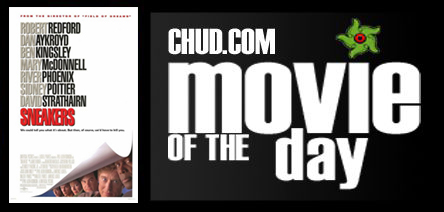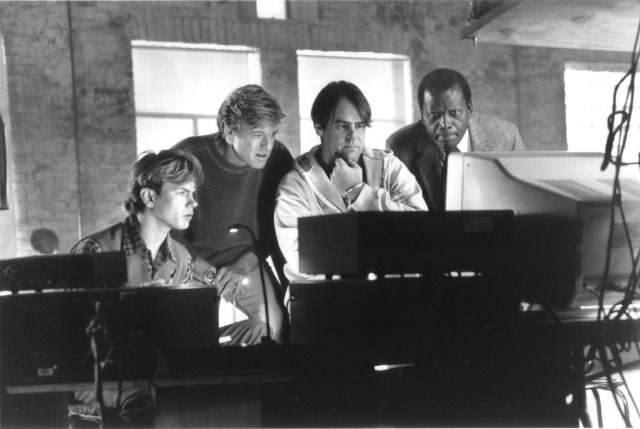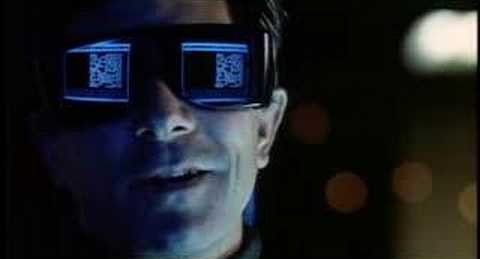
The Film: Sneakers (1992)
The Principals: Robert Redford, Dan Aykroyd, Ben Kingsley, Mary McDonnell, River Phoenix, Sidney Poitier, David Strathairn. Directed by Phil Alden Robinson.
The Premise: The film opens in 1969. Two college computer hackers, Martin Brice and Cosmo, are hackin’ away late at night. Martin decides to make a pizza run. While he’s away the cops show up and bust Cosmo. This is a pivotal moment in Martin’s life. We cut to the present, where Martin (Robert Redford) has now changed his last name to Bishop. He has continued his life of sneaky hacking, but now uses his powers for good (or at least is using them legally). He runs a special team of misfits – the conspiracy nut (Aykroyd), the surly ex-FBI guy (Poitier), the young guy (Phoenix), and the blind guy (Strathairn) – who together get hired by banks and other organization to test their security systems by breaking into them. Then the NSA show up. They reveal to Martin that they know about his past, but are willing to overlook certain things if he and his team will retrieve a special decoding device from a mathematician (a young Donal Logue). Long story short, they eventually realize that these guys aren’t the NSA and people start getting killed. Now Martin and his team need to stay alive, while uncovering the secrets of Janek’s device.

Is It Good: They don’t make ’em like this anymore. Well, in truth, they didn’t make ’em like this back in 1992 either. I don’t know that there is any era where Sneakers truly fits in, now that I’m thinking about it. Though it definitely harkens back to a simpler time when a star-studded thriller could still be fun without helicopter chases, shaky-cam, and epic martial arts fights. It is kind of like The Conversation processed through the mass-appeal machine. There is nothing big or flashy about Sneakers. Nothing profoundly iconic. It is just good. Very good. It is almost hard to put a finger on the source of its goodness.
In fact, there are many reasons why Sneakers shouldn’t work. The characters on Martin’s team are somewhat poorly defined (a glaring hole which is cleverly plugged by some great casting). We never learn how the team was formed, or how they know Martin. While they each have personalities, they don’t necessarily have characters. Aykroyd and Strathairn are at least given quirky traits to delineate them (paranoid, blind). But much is made of the fact that Poitier used to be in the FBI, and it seems like at some point we’ll learn why he left/was kicked out. But we don’t really. And Phoenix barely even has a personality; there is nothing to give us a bead on him until the final scene of the film. But it doesn’t really matter, because it is Phoenix (which meant a lot more in 1992 than it does now, granted). Same for Poitier. More importantly, the rapport between Martin’s team is movie-fun-time at its best. The actors all click and the dialogue provided by Robinson and co-writers Lawrence Lasker and Walter F. Parkes is William Goldman-grade genial banter at its finest.
The film is also completely ridiculous, on paper at least. Few movies are guiltier of what I call “magic tech,” where fancy technology is used in such a fashion that it might as well be the work of a sorcerer. There is a lot of “Zoom in on that. Can we make it clearer?” moments while our characters examine video images. At times you half-expect Redford to ask, “That car is blocking the view… can we digitally remove the car to see behind it?” There is also a moment – after Redford has been abducted and taken for a ride in the trunk of a car – when Strathairn and Redford retrace Redford’s path by recreating the sounds he heard while inside the trunk. The scene is utterly preposterous… and fantastic! And not fantastic because it is preposterous. This isn’t that kind of movie. Fantastic because Robinson pulls it off. He makes it just believable enough that you can be hooked in by the moment, then reeled into the suspense. It is one of the most memorable scenes in the film actually.

Sneakers has a lot of great suspense moments – chief among them being a Mission Impossible-esque sequence where Redford needs to retrieve an item from a room protected by a security system that prevents Redford from moving faster than one cm per second (or something like that) – but it is the characters and cast that make this film work, and oh-so rewatchable.
Mary McDonnell is the secret weapon in the film. She is almost perplexingly sexy, really demonstrating for all other actresses out there that sex appeal isn’t based solely on your looks (not to say that McDonnell is ugly or anything). As the one woman in a sausage-fest, McDonnell actually anchors the best sequence in the film – a conjob disguised as a dating service match up, in which McDonnell needs to get a dweeby toy-maker (played by the incomparable Stephen Tobolowsky) to say a series of certain words throughout the evening so that Redford and his team can get through a voice-recognition security check point. As usual, Tobolowsky owns every moment he’s on screen, and manages the tricky task of not allowing us to feel sorry for someone in a truly sympathetic scenario – without resorting to being overtly creepy or prickish. Just little things, like the way he eats his Chinese food, is subtle acting at work. And watching McDonnell’s character struggle to pretend that she thinks “passport” is the sexiest word in the English language, and that she finds Tobolowsky’s nasally whine to be Barry White-level dreamy? Comic gold.
Also, Ben Kingsley + ponytail = 🙂
Is It Worth A Look: For a long time now this has been a film I never hesitate to recommend to anyone. It is just objectively fun enough, that even if you don’t really respond to the movie, you certainly won’t dislike it. I also recommend it a lot to “dads” (ie, middle-aged men), as it definitely has a “I’m getting too old for this shit” theme to it that dads all dig.
This is a talking movie, first and foremost. One of the more exciting sequences is Redford trying to decode an anagram using Scrabble pieces. There isn’t a ton of action, but there is a lot of entertaining suspense – all squeezed from wondering if our characters will be caught doing something or how they’ll talk their way out of a situation after already being busted.
This is the sort of movie that sadly always gets lost to time. Because there is no reason you need to see it. It is not a definitive masterpiece of its genre, and Robinson has not had the kind of career that will inspire future generations of film buffs to examine his oeuvre; there will never be Phil Alden Robinson completists. But if you watch it. You’ll like it.
The highest praise I can think to give the movie is this…
From talking to people about Sneakers over the years, I would say the world can easily be broken down into two groups of people: 1) those who have never seen Sneakers, and 2) those who love Sneakers.
Random Anecdote: Strathairn’s character, the almost superpowered Whistler, is based on an actual dude, Joe Engressia (known as Joybubbles). Engressia, though completely blind, had perfect pitch and discovered a way to make free phone calls by whistling into a phone receiver to imitate dial tones. Though the movie takes everything to the nth-degree of plausibility, most of the film’s tech and ideas are based in reality. Even the crucial plot-point “Setec Astronomy” was a real NSA funded program at the time.